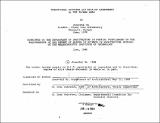| dc.contributor.advisor | N. John Habraken. | en_US |
| dc.contributor.author | Hu, Jone-Hui | en_US |
| dc.contributor.other | Massachusetts Institute of Technology. Dept. of Architecture. | en_US |
| dc.coverage.spatial | a-cc--- a-ch--- | en_US |
| dc.date.accessioned | 2012-11-19T19:05:17Z | |
| dc.date.available | 2012-11-19T19:05:17Z | |
| dc.date.copyright | 1984 | en_US |
| dc.date.issued | 1984 | en_US |
| dc.identifier.uri | http://hdl.handle.net/1721.1/74762 | |
| dc.description | Thesis (M.S.)--Massachusetts Institute of Technology, Dept. of Architecture, 1984. | en_US |
| dc.description | MICROFICHE COPY AVAILABLE IN ARCHIVES AND ROTCH | en_US |
| dc.description | Includes bibliographical references. | en_US |
| dc.description.abstract | This thesis presents an explicit model for the study of the Chinese house, In the past, most research on the traditional Chinese architecture did not deal with the morphology of buildings, so that we often had to rely on the creative leap, once we applied those spatial characteristics of Chinese architecture to the contemporary context. Thus, this study attempts to make use of the morphological approach to analyze the traditional courtyard houses in Taiwan, derive a thematic system for such buildings and its rules to generate contemporary Chinese dwellings. The study begins with an analysis of physical forms starting from the dwelling level to the furniture level, through which a series of rules will be abstracted. On the dwelling level, the issues of spatial organization, spatial sequence and relationship will be addressed. On the room level and the furniture level, this study will further explore the individual spatial properties and the arrangements of furniture. In addition, two dwelling types of the contemporary walk-up apartments will be proposed for further reference, based on the selected rules. A design method is also adopted to illustrate the way in which traditional patterns can be applied to the physical design. Finally, five immediate issues are raised for further research: 1. Adaptation of Traditional Patterns 2. The Support Model 3. Surrounding Context 4. Evaluation of Design Process and Environmental Quality 5. Research model | en_US |
| dc.description.statementofresponsibility | by Jone-Hui Hu. | en_US |
| dc.format.extent | [1], 140 p. | en_US |
| dc.language.iso | eng | en_US |
| dc.publisher | Massachusetts Institute of Technology | en_US |
| dc.rights | M.I.T. theses are protected by
copyright. They may be viewed from this source for any purpose, but
reproduction or distribution in any format is prohibited without written
permission. See provided URL for inquiries about permission. | en_US |
| dc.rights.uri | http://dspace.mit.edu/handle/1721.1/7582 | en_US |
| dc.subject | Architecture. | en_US |
| dc.title | Traditional patterns and walk-up apartments in the Taiwan area | en_US |
| dc.title.alternative | Towards a tentative model for the contemporary walk-up apartment based on the Chinese courtyard houses in the Taiwan area | en_US |
| dc.type | Thesis | en_US |
| dc.description.degree | M.S. | en_US |
| dc.contributor.department | Massachusetts Institute of Technology. Department of Architecture | |
| dc.identifier.oclc | 11721909 | en_US |
